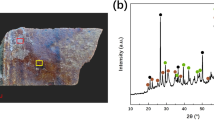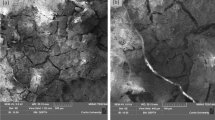Abstract
DURING the study of polished sections of manganese ores from the Kodur Group of mines, Srikakulam Dt., Andhra Pradesh, India, I came across three different types of jacobsite, associated with other manganese minerals like braunite, hausmannite, pyrolusite, cryptomelane, coronadite and γ-MnO2. It is the interesting variation in the colour and etch behaviour in the different types of jacobsite that attracted my attention, and investigations to find out the cause of such variation were attempted.
This is a preview of subscription content, access via your institution
Access options
Subscribe to this journal
Receive 51 print issues and online access
$199.00 per year
only $3.90 per issue
Buy this article
- Purchase on Springer Link
- Instant access to full article PDF
Prices may be subject to local taxes which are calculated during checkout
Similar content being viewed by others
References
Ramdohr, P., “Die Erzmineralien und Ihre Verwachsungen”, 718 (1955).
Uytenbogaardt, W., “Tables for Microscopic Identification of Ore Minerals”, 173 (Princeton Univ. Press, 1951).
Mason, B., Geol. Foren. Forhandl., 65, 146 (1943).
Author information
Authors and Affiliations
Rights and permissions
About this article
Cite this article
ROY, S. Variation in Etch Behaviour of Jacobsite with Different Cell Dimensions. Nature 183, 1256–1257 (1959). https://doi.org/10.1038/1831256a0
Issue Date:
DOI: https://doi.org/10.1038/1831256a0
Comments
By submitting a comment you agree to abide by our Terms and Community Guidelines. If you find something abusive or that does not comply with our terms or guidelines please flag it as inappropriate.



